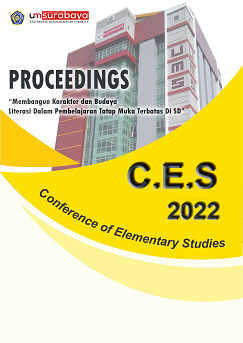ANALISIS BUTIR SOAL EVALUASI PEMBELAJARAN PKn KELAS IV SEKOLAH DASAR DENGAN ITEMAN DI KECAMATAN BANJARNEGARA
Abstrak
The study has an aim to analyze the multiple-choice questions in the final exam of Civic Education subject for the elementary school in Banjarnegara District. It applied a quantitative-descriptive approach. The sampling methods used here are random, stratified, and proportional sampling. From the sampling, it gave 10 schools, 4 core and 6 additional schools. The qualitative analysis applied a review and the quantitative one used the computer software of ITEMAN 3.00 and the manual method. The result of qualitative analysis shows the questions have agreed with the standard, but need some improvements of materials, construction, and language/culture in some parts. The quantitative analysis proves that difference impact of the questions is poor (3%), satisfactory (11%), and good (86%). The questions difficulty level is too difficult (8,5%), moderate (68,5%), and too easy (23%). The effectiveness of the distractor in the question is effective (57%), ineffective (43%). The reliability of the items in a whole reaches 0,839, meaning the questions have a high consistence. From those results, it can be concluded that the questions are matched to the standard, but they need some improvements of materials, construction and language/culture. The questions have a good difference impact, a moderate difficulty, and an effective distractor. In addition, the questions are also highly reliable. Using item validity calculation, it is known that there is one invalid question, i.e. the item 8.
Â
Keywords: an Item Analysis; ITEMAN; Difficulty Level and Discrimination Power
Referensi
Allen & Yen.1979. Introduction to Measurement Theory. Belmont, California: Wadsworth, Inc.
Arikunto, S. (2016). Dasar-dasar evaluasi pendidikan (2nd ed.). Jakarta: Bumi Aksara.
Azwar, S. (2012). Tes prestasi fungsi pengembangan pengukuran prestasi belajar. Yogyakarta: Pustaka Pelajar.
Bers, T.H. 2008. The Role of Institutional Assessment in Assessing Student Learning Outcomes. New Di-rections for Higher Education, 141: 31-39.
Crocker, L. & Algina, J. 2008. Introduction to Classical and Modern Test Theory. Ohio: Cengage Learning
Chellamani, C. &. (2013). Analysisi of Test Items on Difficulty Level and Discrimination Index The Test For Reseach in Education. International Journal of Social Science & Interdisciplinary Research, 189-193.
Drost, E.A. Validity and Reliability in Social Science Research. Education Research and Perspectives, Vol.38, No.1, 2012.
Fitri Alfarisa, Ima Ni’mah Chudari, & Firman Robiansyah. Analisis Butir Soal IPS Kelas V Sekolah Dasar Menggunakan Software ITEMAN. EduBasic Journal: Jurnal Pendidikan Dasar, 1(2), (2019): 100-106
Ismail, Burud, K. N. (2019). Impact of distractors in item analysis of multiple choice questions. International Journal of Research in Medical Sciences, 1136-1139.
Kaplan, R.M. & Saccuzzo, D.P. 2005. Psychological Testing: Principles, Applications, and Issues (6th edition). Belmont, CA: Thomson Wadsworth.
Kubiszyn, T. & Borich, G.D. 2013. Educational Testing and Measurement: Classroom Application and Practice (10th edition). Hoboken, NJ: John Wiley & Sons, Inc.
Kunandar. (2015). Penilaian Autentik. Jakarta: PT Raja Grafindo.
Junaidi, Lababa. Analisis butir soal dengan teori tes klasik: Sebuah pengantar. Jurnal Iqra' Volume 5 Januari - Juni 2008.
Mardapi, D. (2012). Pengukuran, penilaian dan evaluasi pendidikan. Yogyakarta: Nuha Medika.
Mahjabeen, W., Alam, S., Hassan, U., Zafar, T., Butt, R., Konain, S., & Rizvi, M. (2017). Difficulty index, discrimination index and distractor efficiency in multiple choice questions. Annals of Pakistan Institute of Medical Sciences, 13(4), 310–315
Muhson, A. (2015). Kelayakan anbuso sebagai software analisis soal bagi guru. Jurnal Kependidikan, 210.
Nunnally, J.C. & Bernstein, I.H. 1994. Psychometric Theory (Third Edition). New York: McGraw-Hill, Inc.
Pollard and J. Collins, Reflective teaching. A&C Black, 2005.
Pusat Penilaian Pendidikan. 2005. Panduan Penulisan Soal Pilihan Ganda. Jakarta: Balitbang-Depdikbud
Puskur 2008. Model Penilaian Kelas Kurikulum Berbasis Kompetensi. Jakarta: Balitbang Depdiknas.
Qasem, M.A.N. A Comparative Study of Classical Theory (Ct) and Item Response Theory (Irt) In Relation To Various Approaches of Evaluating the Validity and Reliability of Research Tools. IOSR Journal of Research & Method in Education (IOSR-JRME) Volume 3, Issue 5, pp 77-81, 2013..
Rahmawati. (2012). Analisis Butir Soal Matematika Pada UKA PLPG LPTK Fakultas Tarbiyah IAIN Antasari Banjarmasin.
Raymond, J.E., Homer, C.S.E., Smith, R. & Gray, J.E.2012. Learning through Authentic Assessment: An Evaluation of a New Development in the Un-dergraduate Midwifery Curriculum. Nurse Edu-cation in Practice, 30: 1-6.
Stiggins, R.J. & Chappuis, J. 2012. An Introduction to Stu-dent Involved Assessment for Learning (Sixth edi-tion). Boston: Pearson assessment training institute.
Sudjana, N. 2011. Penilaian Hasil Proses Belajar Meng-ajar. Bandung: Remaja Rosdakarya.
Susilowati. 2013. Kurikulum 2013, 87 Persen Guru Kesu-litan Cara Penilaian, (Online), (http://unnes.ac.id), diakses 18 November 2013.
Zhou, Q., Huang, Q., & Tian, H. (2013). Developing students ’ critical thinking skills by task-based learning in chemistry experiment teaching, 4(12), 40–45.






